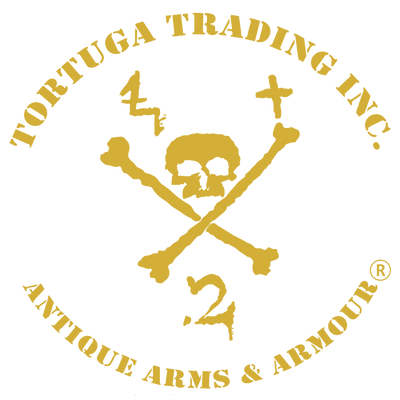AMERICAN REVOLUTIONARY WAR British Military 2nd Model Flintlock Brown Bess Service Pattern 1768/1777 Musket LIEGE CONTRACT, #3209 Firearms
A Good AMERICAN REVOLUTIONARY WAR British Military 2nd Model Flintlock Brown Bess Pattern 1768/1777 Service Musket LIEGE CONTRACT, circa. 1777/78 most certainly captured and used by the American Colonial Forces. 42", .80 cal. round steel barrel w/remnants of (2) Tower proof marks under a thick rust age patina, 'IG' (LIEGE CONTRACTOR, Jean Gosuin) struck on the upper left side of breech. In original flintlock configuration. Lock plate measures 6. 7/8" and is of the 1777 pattern. All the original lock markings are now illegible due to the heavy salt and pepper pitting/age patina and may have been intentionally removed as it was a common practice for the American forces to remove the British markings; cock (hammer) is an earlier 1st long land pattern or early 2nd model replacement done during the period of use. Brass regulation furniture has an untouched pleasing dark olive green/brown age patina. All steel parts have an untouched dark brown /black age patina and has the 'PRATT'S' second ram rod pipe. Stock has a 'Stores Keeper' mark on the right side of the comb under the thick dark varnish, inspector's marks stamped just below the rear of the trigger guard. Original sling swivels. The stock has the initials 'J A' carved on the right face of the comb; is missing some chips around the lock mortise; w/normal scratches and dings from years of service. 57.5" overall length. Steel ram rod. In good working mechanical order and most certainly saw service in the American Revolutionary War, 1776-1783.
Note: The British Crown made it very clear that any weapons issued to the Regulars could NOT be altered or personalized in any way and they were to be maintained to the best order and expected to be returned to the arsenal stores unaltered or molested. The American forces were not under such regulations. In fact, all able body men when called, were to report with their own weapon and when it was possible, weapons would be provided. The onset of the war made the Colonies desperate for ANY weapons and resorted to importing and making weapons out of any available serviceable parts. It was a common practice for all American forces (Continental Army, Navy and Militia) to customize their weapons especially those British marked weapons. The removal of the British markings were due to the hatred of Great Britain and King George but more important, if captured, the British authorities could not prove that the weapon was stolen which had stiff penalties.
LIEGE CONTRACT - When France joined the American rebellion in 1778, a global war began. Great Britain was needed to expand its weapons production and was forced to order contracts of over 100,000 longarms from European manufactures. The Tower Ordnance supplied temp-lets to Liege to be copied. 'IG' (LIEGE CONTRACTOR, Jean Gosuin) was one of many Liege gun makers to fill a 60,000 musket contract ordered by the English Tower of London Ordnance. The muskets are very similar but do have minor differences that can be distinguished. The barrels will be marked with the maker's mark; the lock will have larger and wider engraved markings; the butt plate 'tang' will be shorter, and generally, known musket examples encountered will not be of the same overall quality as those the English produced.
Ref: See; BATTLE WEAPONS of the American Revolution. by, George C. Neumann. c. 1998, pp. 66.
Consignment; D.R. 2014
ARVQQA14



